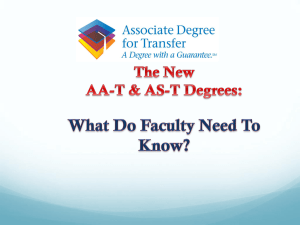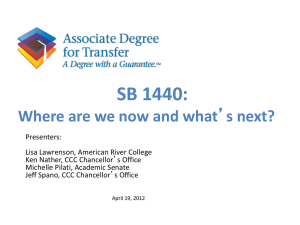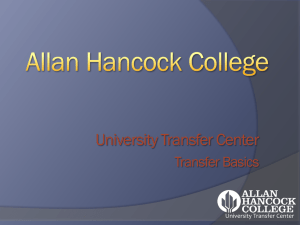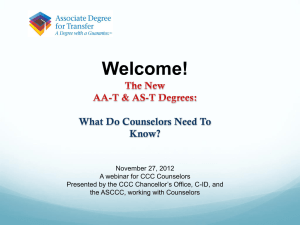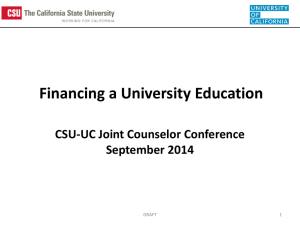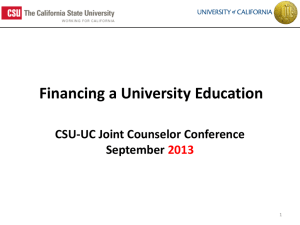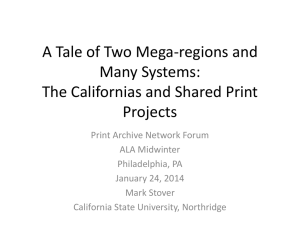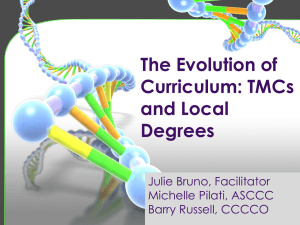Train the Trainer: Informing Counselors about AA-T and
advertisement
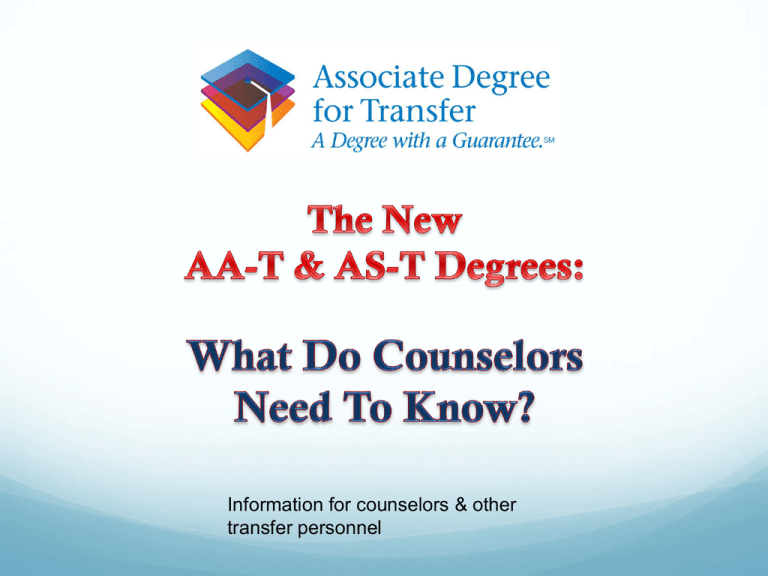
Information for counselors & other transfer personnel AKA: “STAR Act”: Student Transfer Achievement Reform CEC §66745-49 (“Ed Code”) Goal: increase CCC transfers with associate degrees Increase number of associate degrees awarded Reduce units/cost before & after transfer Smoother path to transfer to a CSU A guarantee at CSU Ed code §66745-49 says: All CCCs must offer associate degrees for transfer (to CSU) Degrees include o 60 sem./90 qtr. CSU-transferable units o Completion of IGETC or CSU GE-Breadth o Minimum 18 sem./27 qtr. units in major o No additional local requirements allowed Academic Senates (CCC and CSU) CSU and CCC Chancellor’s Offices C-ID Curriculum chairs Articulation officers Transfer Center Directors Discipline faculty Counselors Administrators 112 colleges develop unique degrees in each major. . . OR A concerted, statewide, intersegmental Transfer Model Curriculum (TMC) 1. Faculty discipline groups: • identify common lower division major preparation (TMC) • define content for courses (C-ID course descriptors) 2. Discipline groups are intersegmental (CSU and CCC) • some UC involvement, too 3. Draft TMCs are vetted statewide (www.c-id.net) & faculty determined. 4. Drafts of Course descriptors (C-ID) vetted statewide 5. CCCs develop TMC- aligned degrees (AA-T/AS-T) and submit them to the CCCCO for approval. Each CSU determines if the TMC is similar “Similar” means a transfer student arrives with the TMC coursework and lower-division GE ,and the CSU campus can deliver the baccalaureate degree in 60 units. (60 + 60) Some options/ concentrations within majors may not be considered similar. Upper-division GE must be part of the 60 units. Any missing lower-division major preparation or American Institutions requirements may be included in the CSU 60 units Many TMCs already found to be similar Departments at each CSU determine “similarity” of each TMC to degree options Some “similar” majors are limited to specific major concentrations or options. Official repository for “similar” majors: www.sb1440.org Administration of Justice Kinesiology Art History Mathematics Business Administration Music Communication Studies Psychology Early Childhood Education Physics Elementary Education Political Science English Sociology Geology Studio Arts Geography Theater History And: MORE are coming! Journalism Insert AA-T in ____ Insert AS-T in _____ Etc. Insert . . C-ID = Course Identification Numbering System Administered by the Academic Senate for CCC Facilitates the identification of comparable courses (“common course numbering”) & increases articulation across all systems of higher education Provides the infrastructure for TMCs & course substitution. Replaces the old “CAN” system. We articulate to course descriptors, not course to course ( a different way to articulate). AOs send all your courses in new degrees to C-ID.org When a college has a C-ID approved course, then they have agreed to accept all others with the same C-ID number. www.c-id.net Streamline student transition from CCC to CSU Earn AA-T or AS-T for completion of CSU GE-Breadth or IGETC and 18 units in major in the TMC-aligned degree No other local CCC graduation requirements. Enhanced CSU admission opportunities Guaranteed priority admission with junior status to a CSU campus with “similar” major After transfer to CSU, guaranteed degree completion within 60 semester units at the CSU Lower cost to students and taxpayers Access to out of area CSUs GPA bump for impacted majors and/or campuses (Note: student may need to be more competitive) New degrees are called Associate in Arts or Science in <major> for Transfer: AA-T or AS-T Degrees include o 60 sem./90 qtr. CSU-transferable units o Completion of IGETC or CSU GE-Breadth o Minimum 18 sem./27 qtr. units in major o No additional local requirements allowed Chancellor’s Office says that based on curriculum offered at your college in alignment with the TMC, CCCs will need to offer many more degrees Details forthcoming from ASCCC and Chancellor’s Office Memo: http://www.c-id.net/docs/2012_522_SB1440_Memo_js.pdf New ASCCC statement on Reciprocity, Course Substitution and Credit by Exam— in light of AA-T and AS-T degrees Counselors can use C-ID for comparability. (Please encourage college to send in CORs to C-ID) External Sources of Credit (AP, CLEP, IB) Credit by Exam Guaranteed admission to CSU system as a junior “The California State University shall grant a student priority admission to his or her local California State University campus and to a program or major that is similar to his or her community college major or area of emphasis“ o “similar” major determined by CSU facultywww.sb1440.org o CSU cannot require students to repeat courses similar to those completed at CCC AA-T and AS-T students admitted to CSU in a “similar” 120-unit BA/BS program are guaranteed to complete BA/BS in 60 semester units Offer workshops for students on the CSU transfer options Update catalog, transfer brochure and GE guide, transfer web page, major sheets, etc. Attend CSU Counselor Conference Provide input as local AA-T/AS-Ts are developed Check resources often: http://www.sb1440.org http://ccctransfer.org/ http://www.calstate.edu/transfer/degrees/ www.ADegreeWithAGuarantee.com. This degree can work for anyone targeting a CSU o Alternate pathway to major prep as in ASSIST Degree works especially well for students who… o Want to earn AA/AS and prepare to transfer o Are applying to a non-local CSU o Are applying to a CSU which has no articulation with your CCC o Are applying to a CSU with “similar” major o Are applying to impacted CSU (campus or major) Now has benefit for UC too May also be strong preparation for elsewhere AA-T/AS-T Major Preparation CSUGE or IGETC AI, Golden 4, Electives * 60 units = CSU Major coursework( similar) 60 units YOUR BACHELOR’S DEGREE CSU General Education (upper division) The CSU Admission Process California State University Office of the Chancellor The “Similar Degree Determination Process CCC campuses build/modify a proposed degree which fits within the TMC template = AA-T/AS-T CSU campuses review the TMC templates to determine whether the undergraduate preparation would allow a student to successfully complete the bachelor's degree within 60 additional units. Campuses have been given strategies to get more majors and options into the “similar” category CSU Minimum Admission Requirements Met by the AA-T/AS-T which includes: 60 semester units or 90 quarter units that are eligible for transfer to the California State University. And either the Intersegmental General Education Transfer Curriculum (IGETC-CSU) or the CSU GE-Breadth Requirements Including Golden Four (A3‐‐critical thinking, A1‐‐communication, A2‐‐English composition, and B4‐‐quantitative reasoning w/a minimum grade of “C”) GE Certification is not required A minimum of 18 semester units or 27 quarter units in a major or area of emphasis Obtainment of a minimum grade point average of 2.0 What’s the Guarantee? (the fine print) 1. A student who completes an Associate’s Degree for Transfer at a California Community College is guaranteed admission to the California State University No guarantee to any particular campus or program. To qualify: The student must be conferred an AA-T or AS-T degree Apply for admission to California State University campuses for an open term by the published deadline Submit all requested transcripts and documents by published deadlines, Meet CSU admission eligibility requirements for the program to which they have applied, And comply with any other prescribed admission requirements. What’s the Guarantee? 2. AA-T/AS-T graduates who are admitted to a CSU program that has been deemed similar to the Associate’s Degree for Transfer will be able to complete the Baccalaureate Degree in the similar option in the discipline within 60 semester or 90 quarter units As long as the student successfully completes each required course without repeating them. Or supplementing instruction with additional courses for minors or areas of emphasis. Continuous enrollment in the same academic major is required unless the student is on an approved leave of absence. To maintain the guarantee, continuous enrollment in the same academic major is required unless the student is on an approved leave of absence. After enrollment at a CSU campus begins, the guarantee is not transferable to another CSU campus. How are AA-T/AS-T degrees considered in admission? CSU Campus Admissions Impaction Status No Impaction Similar Degree Local Applicant Similar Degree Non-Local Applicant Priority Admission Min. 2.0 GPA (Ed. Code 66745) Campus Impacted Priority Admission Min. 2.0 GPA (Ed. Code 66745) Program Impacted (Any CA Student) Campus & Program Impacted (Any CA Student) Supplementary GPA Requirement Additional .20 GPA Point Supplementary GPA Requirement Additional .10 GPA Point (20 seats or more) Supplementary GPA Requirement Additional .10 GPA Point (20 seats or more) THE ADMISSION PROCESS CSU Updates to Policies and Procedures Counselor & Educator publication updates Mandatory catalog updates Coded Memorandum on SB 1440 implementation Communication with outreach, articulation, admissions, registrars, advising, etc. Admission Process CSU Mentor: New SB1440 Section on 2012-2013 Application Application Verification Process Student self-reported applicant responses to AA-T/AS-T questions from CSU Mentor Applicant data disaggregated by CCC and CSU Student data sent to CCCCO SB1440 Implementation & Oversight Committee and CSSO group determine the verification timeline for each term Timeline includes petition to graduate verification dates Determines the CSU communication to applicants on process Applicants provide evaluation documents to CSU Spring 2013 Verification Timeline Application Verification Process “AA-T or AS-T” degree applicants who’s self reported information on CSU Mentor meet the basic eligible standards (i.e. CCC, degree) are sent email communication from the CSUCO with instructions on the evaluation requirement Application Verification Process Instructions to access secure individual campus files provided to identified contacts at CSU and CCC Students who petitioned for degree are expected to provide a copy of their evaluation/report to CSU campuses to which they had applied Students required to provide final transcript showing awarding of AA-T/AS-T degree to CSU Admissions Evaluation All applicants still must follow campus instructions regarding documents and other requirements Local campus process varied by impaction status: Campuses continuing to admit all CSU eligible upper division transfers could continue with existing processes Campuses which were impacted at the upper division transfer level or by major(s) reviewed groups of applications based upon potential impact of AA-T/AS-T consideration Fall 2013 CSU Process Enhancements Built-in validation of CCC and AA-T/AS-T major reported in CSU Mentor Improved ability for redirecting verified AA-T/AS-T applicants who are not admitted to the impacted major or campus Ongoing rethinking of verification process www.calstate.edu A student at your college wants to study Communication at CSULA. Questions: Is the AA-T in this major offered at your college? Is a similar major offered at CSULA? Is the major/campus impacted? Is your college in CSULA’s local admission area? SB1440 does not pertain to UC, but. . . UC has added two eligibility pathways for transfer admission: (1) Completion of a UC Transfer Curriculum (in the major), and (2) completion of an approved Associate Degree for Transfer (in the major) from a California Community College. What about UC? What does this mean? AA-T/AS-T guarantees a Comprehensive Review Most AA-T/AS-T applicants will be wellprepared to compete When choices are available, students will want to select the most rigorous options as outlined in the UC Transfer Preparation Paths (e.g., IGETC over CSU Breadth) What are UC Transfer Curricula? UC faculty are discussing lower-division major prep in light of the TMC and existing commonalities across UC Fall 2010: Math, Bio, Psych, Comp Science, & History Spring 2011: Sociology and Physics Additional disciplines expected in 2012-13 A great deal of similarity already exists, but conversations continue on the campuses and at the system level More TMCs and local AA-T/AS-T degrees being developed New information will be added to the websites Thank you for participating!
